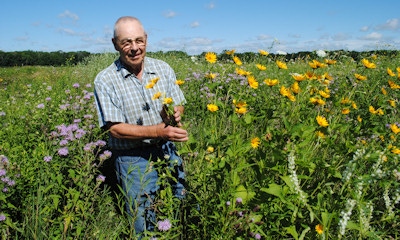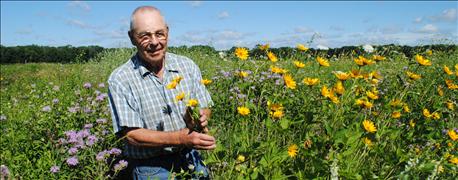
Pollinators, including bees and butterflies, are essential to agriculture. One in three bites of food in the U.S. is dependent on pollinators. According to the USDA, $15 billion worth of crops, including more than 130 fruits and vegetables, are pollinated every year.
Honey bee numbers have been on the decline during the past 50 years. Since 2006, 30% of honey bee hives in the U.S. have been lost each winter to diseases, parasites, poor nutrition and pesticide exposure.
To address the concerns, NRCS in Wisconsin has dedicated more than $2 million through the Environmental Quality Incentives Program, for practices to increase and improve honey bee food sources.

FLOWER POWER: Farmers like Al Messner who farms near Oakfield in Fond du Lac County, have been planting flower and grass seed on their farms which is helping improve habitat for pollinators.
Monarch butterfly populations have been declining in the U.S. for the past two decades. One of the many factors contributing to this decline is the shrinking number of milkweed plants. Milkweed is a critical component in the monarchs’ reproduction cycle.
The monarch butterfly is one of the most well-known butterflies in the United States and North America. The iconic orange and black butterfly is known for its annual migration from Mexico through the United States to as far north as Canada.
During their journey north, monarchs lay their eggs on milkweed. In the past two decades, populations have decreased significantly in part because of the decrease in native plants including milkweed on which their caterpillars feed. Agriculture and development have removed much of the native milkweed that once spanned the country.
Because monarchs are always on the move, they need to have the right plants at the right time along their migration route. Caterpillars need to feed on milkweed to complete their lifecycle and adult butterflies need nectar producing flowers in bloom for energy.
In 2015, NRCS began working with farmers to combat the decline of monarchs by planting milkweed and other flowers on farms. To accelerate conservation to benefit monarch butterflies, NRCS is targeting conservation efforts at the heart of the butterfly's migration route. Assistance is available to producers in 10 states in the Southern Plains and Midwest including Wisconsin, Illinois, Indiana, Iowa, Kansas, Minnesota, Missouri, Ohio, Oklahoma and Texas.
Developing habitat
Al Messner a farmer and retired Oakfield High School science and math teacher, owns 340 acres near Oakfield. He is a longtime conservation advocate and has participated in the Conservation Reserve Program since it began in 1986.
In 2007, Messner put in grass filter strips and had a nutrient management plan done for his farm.
Once the filter strips were in, Messner seeded a mixture of prairie grasses and wildflowers on them.
“We enjoy the purple prairie clover and black-eyed Susans and the wildlife and butterflies all spring, summer and fall,” says his wife, Judi.
Messner, 75, has a total of 110 acres enrolled in the Conservation Reserve Program, 47 acres in the Conservation Reserve Enhancement Program and 15 acres in the State Area for Wildlife Enhancement Program.
Of those acres, a total of 48 acres have been planted to prairie grasses and wild flowers. The mixture includes big bluestem, little bluestem, Indian grass, side oats grama, switchgrass, purple prairie clover, wild bergamot and yellow coneflower. Other flowers and plants that are also growing in those fields are milkweed, butterflyweed, bee balm, sweet clover, purple coneflower and Queen Anne's lace.
“Establishing the filter strips took longer than I thought it would,” Messner adds. “It has been nine years since we put them in. I had to mow the buffers the first four years to control thistles. In 2012, I only mowed 50% where there were thistles, and by the end of summer, I had no thistles.
Messner now mows once every five years in September after the nesting season is completed and monarch butterflies have migrated to Mexico. In June, he spot mows to prevent invasive species like wild parsnip from spreading in his fields.
Since putting in the grassed buffers, he has noticed several improvements.
“Before the grassed buffers were put in, I used to see fertilizer going in the ditch when I spread it near the ditches,” he says. “Now that’s not happening. Everyone benefits from this, but the environment is the big winner.
“Because we have saved the soil, we are benefiting from a lot more wildlife, turkeys, deer, fox, songbirds, ducks, geese, herons, egrets and different kinds of birds we never saw before,” he explains. "Because of all the flowers, we're also seeing a lot more bees, monarch butterflies and other butterflies too."
Messner gets a kick out of giving visitors Gator tours of his farm and especially his fields full of flowers.
"They have a lot of fun seeing all of the beautiful flowers, but I really enjoy showing people the fields."
In addition to all of his conservation efforts, Messner is still actively farming 125 acres.
Conservation pays
Farmers and landowners participating in CRP, CREP are paid similar to what they would get if that land was in corn or soybeans, according to Erv Lescyznski, Fond du Lac County Land Conservation watershed planner.
"In the last three years, CRP payments in east central Wisconsin have increased three times," Lesczynski says. "The amount paid per acre varies by soil type but ranges between $85 and $276 per acre for 10 to 15 years depending on the program."
According to Lesczynski, "We have some individuals with high soil types getting as much as $300 per acre for 15 years."
Farmers can also enroll in the Environmental Quality Incentives Program. Those in EQIP can receive cost sharing on conservation practices including cover crops, wildlife prairie plantings, waterways, filter strips, wetland restorations and prescribed grazing systems (including fencing and waterlines).
EQIP cost sharing typically covers 40% and 50% of the cost of a conservation practice.
"The rest is out of pocket, however, if you are a beginning farmer, or if you an organic producer, or if you are a veteran who is beginning to farm, the cost share for those participants if they get accepted, is closer to 80% to 90%, explains Cory Drummond, conservationist with the Fond du Lac County Land Conservation Department.
To find out more information about growing habitat for pollinators or the EQIP, SAFE, CRP and CREP, contact your local county land conservation office.
About the Author(s)
You May Also Like






